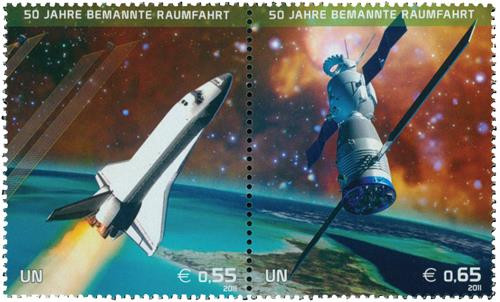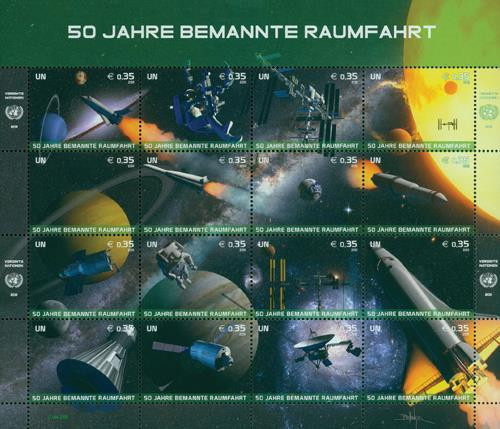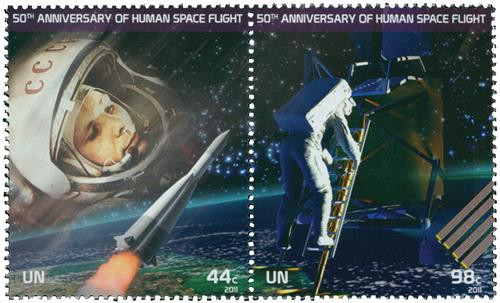
# UNV485 - 2011 United Nations Human Space Flight s/s 2
50th Anniversary of Human Spaceflight
In addition to the three 16-stamp sheets issued to commemorate Yuri Gagarin’s historic first spaceflight, the U.N. also issued a souvenir sheet. The six-stamp souvenir sheet featured two stamps from each nation in a total of six different denominations. This marked the first time the United Nations issued a souvenir sheet in this format.
At the height of the “Space Race” of the 1960s, Russia was usually one step ahead of the U.S. In the end, America was the first country to land a man on the moon. But the first man in outer space was a Russian named Yuri Gagarin.
Gagarin developed an early interest in space and the planets. While studying at a technical high school, he joined the “Aero Club,” learned to fly light aircraft, and dreamed of flying in space. By 1960, Gagarin was a senior lieutenant in the Soviet Air Force.
Gagarin was selected, along with 19 others, as a cosmonaut in the expanding space program. His top performance on physical and psychological tests, along with his short stature (5 feet 2 inches), won him the honor of piloting the Vostok I. On April 12, 1961, at 9:07 a.m., Gagarin entered earth’s orbit and made history as the first man in outer space. The flight took just 108 minutes.
Gagarin immediately became a “Hero of the Soviet Union,” the highest honor awarded by that nation. He was nicknamed “The Columbus of the Cosmos” and traveled the world sharing his experience. Streets, cities, and a crater on the moon have been named in his honor. It’s been said the Russians feared losing him in an accident and wouldn’t allow him to travel into space again, so Gagarin’s first space flight was also his last.
Not content to let Russia dominate space exploration, just weeks after Gagarin’s voyage, President John Kennedy declared America’s intention to send a man to the moon by the end of the decade.
Yuri Gagarin’s successful first human spaceflight was a pivotal moment in space exploration. It gave America the extra push that resulted in Neil Armstrong becoming the first man on the moon in 1969. And with the space race effectively over by that point, both nations soon began working together to achieve more goals in space. The first was the 1975 Apollo-Soyuz Test Project, the first joint U.S.-Soviet space flight. Later collaborations included the Shuttle-Mir Program and the International Space Station.
50th Anniversary of Human Spaceflight
In addition to the three 16-stamp sheets issued to commemorate Yuri Gagarin’s historic first spaceflight, the U.N. also issued a souvenir sheet. The six-stamp souvenir sheet featured two stamps from each nation in a total of six different denominations. This marked the first time the United Nations issued a souvenir sheet in this format.
At the height of the “Space Race” of the 1960s, Russia was usually one step ahead of the U.S. In the end, America was the first country to land a man on the moon. But the first man in outer space was a Russian named Yuri Gagarin.
Gagarin developed an early interest in space and the planets. While studying at a technical high school, he joined the “Aero Club,” learned to fly light aircraft, and dreamed of flying in space. By 1960, Gagarin was a senior lieutenant in the Soviet Air Force.
Gagarin was selected, along with 19 others, as a cosmonaut in the expanding space program. His top performance on physical and psychological tests, along with his short stature (5 feet 2 inches), won him the honor of piloting the Vostok I. On April 12, 1961, at 9:07 a.m., Gagarin entered earth’s orbit and made history as the first man in outer space. The flight took just 108 minutes.
Gagarin immediately became a “Hero of the Soviet Union,” the highest honor awarded by that nation. He was nicknamed “The Columbus of the Cosmos” and traveled the world sharing his experience. Streets, cities, and a crater on the moon have been named in his honor. It’s been said the Russians feared losing him in an accident and wouldn’t allow him to travel into space again, so Gagarin’s first space flight was also his last.
Not content to let Russia dominate space exploration, just weeks after Gagarin’s voyage, President John Kennedy declared America’s intention to send a man to the moon by the end of the decade.
Yuri Gagarin’s successful first human spaceflight was a pivotal moment in space exploration. It gave America the extra push that resulted in Neil Armstrong becoming the first man on the moon in 1969. And with the space race effectively over by that point, both nations soon began working together to achieve more goals in space. The first was the 1975 Apollo-Soyuz Test Project, the first joint U.S.-Soviet space flight. Later collaborations included the Shuttle-Mir Program and the International Space Station.











